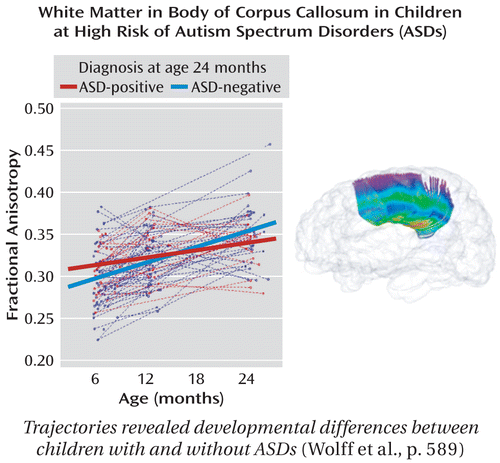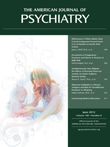In This Issue
Clinical Guidance: Early Brain Changes in Autism Spectrum Disorders
Children who developed autism spectrum disorders (ASDs) by age 2 had greater development of cerebral white matter fiber tracts by 6 months than unaffected children. After the initial accelerated white matter development, the children who developed ASDs had slower development (figure), so that by age 2 their white matter development was less than that in the unaffected children, as found by Wolff et al. (CME, p. Original article: 589). Sowell and Bookheimer in an editorial (p. Original article: 551) point out that these changes predate behavioral changes characteristic of the illness. This information may be helpful in working with families who are trying to understand how autism developed in their child, as the early development of brain changes predates most parent-child interactions.

Trajectories revealed developmental differences between children with and without ASDs (Wolff et al., p. 589)
Clinical Guidance: Psychiatrists and Medical Marijuana
Psychiatrists may be asked by patients for referrals for medical marijuana under legislation in a number of states. Kleber and Dupont (p. Original article: 564) point out that there is no clinical scientific literature to support benefits. Risks to the patient include a supply whose purity and potency are not specified. Particularly problematic is breeding of marijuana to develop more potent strains in which components that limit potential harmful effects have been removed. Effects on brain development and increased liability for risk of other drug abuse are observed in adolescence. In addition, by sanctioning patients' consumption, psychiatrists may contribute to the adverse community impact of the culture surrounding marijuana dispensaries, including criminal behavior. They advise that physicians assume their role of educating patients about risks and benefits, particularly when responding to requests for a nonbeneficial treatment.
Clinical Guidance: Intermittent Explosive Disorder
Intermittent explosive disorder, first introduced in DSM-III, has now received more intensive research and clinical characterization, according to Coccaro (p. Original article: 577). The disorder consists of either high-intensity outbursts of aggression occurring several times yearly or less intensive outbursts several times monthly, a more treatable form. The disorder begins in adolescence or early adulthood; prevalence is about 5%. It appears to be separate from childhood disruptive behavioral disorders, such as conduct disorder and oppositional defiant disorder. Fluoxetine and cognitive-behavioral therapy together appear to have synergistic treatment effects.
Clinical Guidance: Prevention of Bipolar Psychosis Pre- and Postpartum
A clinic in the Netherlands evaluated the effect of lithium prophylaxis on the development of manic psychotic episodes in a case series of women who had experienced previous bipolar disorder episodes (Bergink et al., p. Original article: 609). Women were advised to begin lithium prophylaxis immediately if they had a history of bipolar psychosis outside the postpartum period and to wait for delivery if their history was limited to the postpartum period. Those with a history of bipolar episodes outside the postpartum period had a 24% relapse rate during pregnancy, despite prophylaxis. Sixty percent of these relapsing women had additional episodes during the postpartum period. Women whose episodes had previously been limited to the postpartum period had no relapses before or after delivery if they received postpartum lithium prophylaxis. Those who declined postpartum prophylaxis had a 44% relapse rate. Wisner comments in an editorial (p. Original article: 554) that physicians and women need to make their own risk-benefit analysis, since some but not all women will benefit from prophylaxis.



